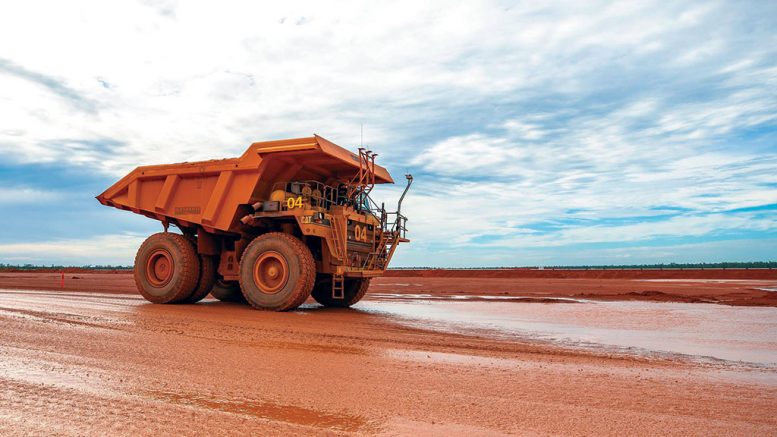Malaysia is set to begin issuing bauxite mining licenses in early 2020, four years after it imposed a ban in response to environmental concerns.
The Southeast Asian nation produced very little bauxite prior to 2014, but when Indonesia, China’s biggest supplier, imposed a ban on exports of unprocessed minerals in January 2014, China turned to Malaysia to fill the bauxite gap.
At the time, Indonesia was providing China with as much 6.5 million tonnes of bauxite per month, roughly 85% of China’s imports, according to bauxite producer Alumina Ltd. Indonesia imposed its ban in the hopes of creating a domestic refinery industry for raw minerals, including bauxite, and stopped its exports to China, which accounted for 60% of global bauxite demand at the time.
Racing to fill the gap, Malaysia ramped up production from a couple hundred thousand tonnes in early 2014 to exporting between 2-3.5 million tonnes per month in 2015, commodities consulting firm Argus Media says.
By the end of 2015, Malaysia was China’s biggest foreign supplier of bauxite and had become a major producer, contributing almost 10% of all bauxite produced globally that year, according to the United States Geological Survey (USGS).
The dramatic ramp-up in production caused problems, however. Poorly regulated operations contaminated water supplies, and the Malaysian government was forced to ban bauxite mining in January 2016, though it permitted its stockpiles to be sold.
Now, Malaysia is ready to step back into the market with a new set of operating rules for bauxite producers to protect the environment, though Argus Media said in 2019 that Malaysia may limit production to just 600,000 tonnes per month as a precaution.
It remains to be seen, however, whether any producers will be willing to return in a significant way to a market with a potentially unpredictable regulatory environment and possibly limited reserves. There also have been sweeping developments in the industry in the four years since Malaysia imposed its ban, presenting major consumers like China with other options.
At the height of Malaysia’s production, Australia was the largest bauxite producer in the world, producing 80 million tonnes of the world’s 249 million tonnes of bauxite produced in 2015. Today, it remains the world’s largest producer of bauxite in the USGS records, even as global production is expected to climb to 367 million tonnes this year, according to the Australian government. This dominance is due to major bauxite mining projects coming online in Australia. For example, Rio Tinto (NYSE: RIO; LON: RIO) brought its 22.8 million tonne-per-year Amrun plant online in 2019 and could further ramp-up production there in the future.

Workers on a bucket wheel at Rio Tinto’s Weipa operation, which includes the new Amrun bauxite mine in north Queensland, Australia. Credit: Rio Tinto.
Australia expects its bauxite production to top 100 million tonnes this year and it has plenty of room to grow with its estimated 5.44 billion tonnes of bauxite reserves — the second-largest reserve capacity in the world. It has long been a major bauxite supplier to China and its exports increased to more than two billion tonnes per month in 2019.
However, the biggest market change since Malaysia’s ban on bauxite mining in 2016 has been the rapid production ramp-up in Guinea, which holds the world’s largest bauxite reserves at an estimated 6.7 billion tonnes, according to the USGS.
In 2015, Guinea produced just 16.1 million tonnes of bauxite, according to the USGS, but jumped to 45.3 million tonnes in 2018, and Fitch Solutions predicted in its May 2019 Global Mining Outlook another increase in 2019, potentially exceeding 60 million tonnes. Though not the only significant investor in Guinea, China has been largely responsible for spurring the growth. Prior to January 2016, Guinea exported almost no bauxite to China but had become its largest single supplier by 2019, providing almost six million tonnes per month by mid-2019, according to Alumina Limited.
New production is coming online each year in Guinea. For example, the Aluminum Corp. of China (Chalco) started shipments from its Boffa mine in January 2020 — the plant will eventually ramp up to 12 million tonnes per year.
At the same time, Indonesia removed its ban in 2017 and ramped up production, from 2.6 million tonnes that year to 6.3 million tonnes in 2018. It is possible that these exports will be short-lived. Indonesia’s recent acceleration of the ban on nickel exports — moving up the deadline for new refinery capacity to avoid an export ban from 2022 to 2020 — has caused some uncertainty regarding the future of its bauxite exports.
Australia, Guinea, and Indonesia together provided more than 95% of China’s bauxite imports in 2019, and represent nearly half of the world’s production (more than half when China’s own production is included), according to USGS data. At the same time, other countries such as India, Brazil, and Jamaica are increasing production to meet bauxite needs in other parts of the world. There is no longer a critical bauxite gap for Malaysia to fill.
All this increased production is likely sufficient to maintain a slight surplus for bauxite this year, according to major aluminum producer Alcoa (NYSE: AA). Alcoa said in its fourth-quarter 2019 earnings presentation that increased production in Australia and Guinea will serve Chinese demand, which it expects to increase by nearly 18.1 million tonnes year-over-year in 2020, partly due to China’s ongoing strategic stockpiling to protect against supply chain risks. The stockpile means that, even if Indonesia does impose a bauxite ban, the market could continue in surplus in 2020.
This surplus situation is unlikely to change in the near-future, given the current aluminum market. Bauxite is the only economical feedstock for aluminum, according to the USGS. For this reason, bauxite was included in the United States Department of the Interior’s list of 35 critical minerals to the security of the country. Bauxite demand is tightly connected to the aluminum market, where prices have been falling steadily since mid-2018.
When Malaysia imposed its bauxite mining ban in January 2016, aluminum prices were on the way up as the auto and construction sectors recovered after the 2007-2008 recession. Transportation consumes 28% of all aluminum and construction consumes a further 23%. Aluminum prices jumped even higher in early 2018, due to the tariffs applied by the United States to several aluminum producing countries and to sanctions imposed on Russian aluminum manufacturer Rusal related to U.S. presidential elections in 2016. The prices peaked at more than US$2,530 per tonne in April 2018, according to the London Metal Exchange (LME).

Aluminum ingots for export in Novorossiysk, Russia. Credit: Leonid Eremeychuk/istock.
Prices have since steadily declined on the LME since mid-2018 to US$1,686 per tonne on Feb. 5, 2020, as the U.S. rolled back its tariff against key aluminum producing countries and removed its sanctions against the restructured Rusal. Another key reason for the decline in aluminum prices is reduced demand. Rio Tinto said in its half-year 2019 results that aluminum demand growth had narrowed to just 1%, impacted primarily by the transportation sector.
The global auto sector suffered in 2019. China continued its 2018 slide in auto sales, posting an 8.2% decline in total sales in 2019 as compared to the year before, and predicting a further 2% decline in 2020, according to the China Association of Automobile Manufacturers. The decline was partly due to the trade war with the U.S., but also to China’s phasing out of electric vehicle incentives in mid-2019. The economic impact of the Wuhan coronavirus outbreak, which has portions of the country and tens of millions of people quarantined and made trade and travel difficult throughout China, could further dampen its auto outlook.
Other major auto markets did not fare much better in 2019. The European Automobile Manufacturers Association (ACEA) said in a January 2020 report that the European Union member states (including the United Kingdom) scraped out a small, 1.2% increase in passenger vehicle sales over 2019, largely due to last-minute incentives in certain countries. The United States just barely cleared 17 million in new auto sales, representing a small decline over 2018. Cox Automotive, which monitors the auto industry, said in a December 2019 release that consumers tapped a record amount of non-housing debt in 2019 to purchase big ticket items like automobiles but that mounting debt defaults and a likely slowdown in 2020 make a second straight year of auto sales declines likely.
The decline is doubly felt in the aluminum industry, as the aluminum content per vehicle is expected to increase as part of automakers’ efforts to produce lighter-weight cars. The Aluminum Stewardship Initiative claims that, for every 10% reduction in the weight of a vehicle, fuel economy increases 7%. As a result, Rio Tinto states on its website that it expects that use of aluminum in lightweight vehicles in North America will increase from 177 kilograms in 2015 to 277 kilograms in 2025. Any decline in overall sales impacts the outlook for aluminum demand now more than ever before. Alcoa said in its earnings presentation that it expects an aluminum surplus this year.
Aluminum and bauxite markets, along with the intermediate feedstock alumina, appear likely to remain in slight surplus for the next few years, analysts say, particularly considering potential economic impacts of consumer debt in the U.S., Brexit, and the coronavirus. Meanwhile, Guinea and Australia have large pipelines of new projects ready to come on stream. In a March 2019 presentation, Alumina Ltd. said it expects Guinea to produce almost 90 million tonnes in 2020. As a result, this could relegate Malaysia to being a small producer.





Be the first to comment on "Malaysia reverses production ban on bauxite"